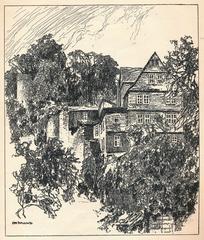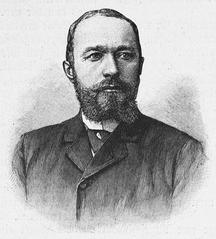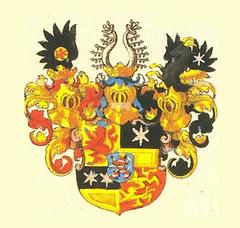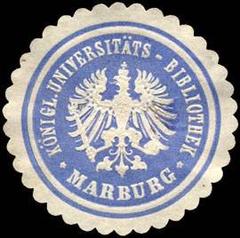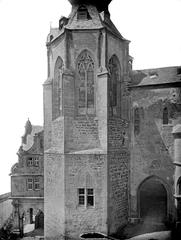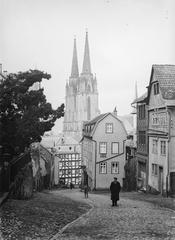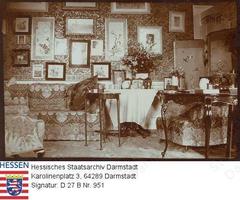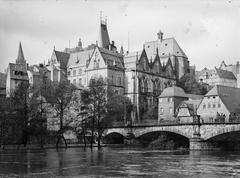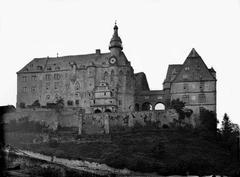
Visiting Cappel, Marburg, Germany: Guide to Tickets, Hours, and Attractions
Date: 04/07/2025
Introduction
Set within the rolling hills of Hesse, Germany, Cappel is a charming borough of Marburg renowned for its blend of medieval architecture, vibrant cultural life, and seamless integration with the city’s academic and historical scene. Whether you’re fascinated by centuries-old churches, eager to explore scenic hiking trails, or looking to immerse yourself in local festivals, Cappel offers a multifaceted travel experience. Its proximity to Marburg’s prominent landmarks—such as Marburg Castle and St. Elizabeth’s Church—makes it an ideal base for discovering the greater Marburg region.
This guide provides detailed visitor information, historical context, practical tips, and recommendations for exploring Cappel and its key sites. For the latest updates, consult official resources like the Marburg-Cappel website and the Marburg Tourism Office.
Table of Contents
- Introduction
- Historical Overview of Cappel
- Visitor Information
- Cultural and Demographic Highlights
- Nearby Attractions
- Frequently Asked Questions (FAQ)
- Practical Visitor Tips
- Conclusion
- References and Further Information
Historical Overview of Cappel
Early Origins and Medieval Development
Cappel’s roots trace back to the early 12th century, first documented as “de Capela” in a charter from 1138–1139. The name reflects the early presence of a chapel, indicating the area’s ecclesiastical importance during the High Middle Ages. By the late 1200s, Cappel had become a rural community centered around agriculture and milling, with the Steinmühle mill first recorded in 1299. The Lahn River and its tributaries played a vital role in the settlement’s development.
In the 14th century, Cappel became one of the “Hausdörfer” (house villages) under the authority of the Landgraves of Hesse, cementing its place within the feudal and administrative structures that shaped the Marburg region.
Religious and Architectural Heritage
The parish church of St. Martin is the focal point of Cappel’s architectural legacy. Built in the late Gothic style in the 14th century, the church was expanded and renovated in Neo-Gothic fashion in 1900. Its enduring presence underscores Cappel’s historical significance as both a spiritual and community hub.
Modern Integration
Following the dissolution of feudal structures in the 19th century and administrative reforms in the 1970s, Cappel was officially incorporated into Marburg on July 1, 1974. Today, it is the largest district outside Marburg’s core, home to around 7,000 residents, and balances its rural heritage with the amenities of a modern suburb.
Visitor Information
Visiting Hours and Tickets
- St. Martin’s Church: Open daily from 9:00 AM to 6:00 PM. Admission is free; donations are encouraged for preservation.
- Steinmühle (Historic Mill): Generally not open for regular tours; can be viewed from the outside. Special events and tours are scheduled seasonally—see the Marburg-Cappel website for details.
Guided Tours and Events
Guided walking tours of Cappel’s historic sites and natural surroundings are available through the Marburg tourism office and local cultural associations. Cappel’s annual village festival features traditional music, crafts, and Hessian cuisine, offering visitors a lively immersion into local culture.
Accessibility and Travel Tips
Cappel is easily reached by bus from Marburg’s city center. The district is well-served by public transport, offers ample parking, and features pedestrian-friendly paths, including a scenic trail around the village pond. Most key sites are accessible, though some historic buildings have steps or cobblestone approaches.
Cultural and Demographic Highlights
Cappel maintains an active local council (Ortsbeirat) and preserves several listed monuments. The village’s coat of arms and flag, introduced in the 1960s, symbolize its historical and geographical identity. Community engagement is strong, and local events foster a vibrant neighborhood spirit.
Nearby Attractions
- Marburg Castle (Landgrafenschloss): A medieval fortress with panoramic views, museum exhibits, and historic architecture.
- Frauenberg Castle Ruins: The prominent ruins of a 13th-century castle, offering hiking opportunities and sweeping vistas (Komoot Highlight).
- Marburg Old Town (Altstadt): Characterized by timber-framed houses, cobblestone streets, and lively university life.
The Cappel Monument: History and Visiting Details
History and Significance
The Cappel Monument, built in the 18th century, commemorates the district’s heritage and notable local figures. It stands as a symbol of community pride, reflecting the architectural style of its era.
Visiting Hours and Tickets
- Open Tuesday to Sunday, 10:00 AM–6:00 PM; closed Mondays and public holidays.
- Ticket prices: Adults €5, seniors/students €3, children under 12 free, family ticket €12.
- Tickets available at the entrance or online via the Marburg tourism site.
Getting There and Accessibility
The monument is located in southern Marburg, accessible by bus lines 3 and 7. Limited parking is available. The site is wheelchair accessible, with ramps and adapted restrooms.
Special Events and Tours
The Cappel Quartiersmanagement organizes guided tours and the annual “Cappel Heritage Festival,” featuring night tours and cultural performances.
Visitor Tips
- Arrive early during festivals to avoid crowds.
- Comfortable footwear is recommended due to cobblestone paths.
- Check the official website for event updates.
Frauenberg Castle Ruins (Burgruine Frauenberg)
Historical Significance
Built in 1252 by Duchess Sophie von Brabant, Frauenberg Castle was a key medieval residence and defensive site. The ruins are a testament to the area’s turbulent history, having withstood sieges and eventual abandonment in the early 16th century (Komoot Highlight).
Visitor Information
- Open year-round, free of charge; no formal ticketing or opening hours.
- While there are no official guided tours, local hiking groups occasionally offer historical walks.
Hiking and Scenic Views
Multiple marked trails—ranging from 6.5 to 25 km—lead to the castle ruins. The site is ideal for hiking, picnics, and enjoying panoramic views of the region. Nearby, the “Baum des Jahres” educational path provides insights into local flora (Komoot Highlight).
Rest Areas and Amenities
Rest spots and picnic benches are available along the trails. As the area is protected, visitors should remain on designated paths and respect the environment.
Practical Visitor Tips
Getting to Cappel and Marburg
- By Train: Marburg Hauptbahnhof is well-connected via the Main-Weser Railway. From the station, Cappel is accessible by buses (lines 1, 2, and 7).
- By Car: Via A5/A485 motorways and B3. Parking is available in both Marburg and Cappel.
- By Bicycle: Dedicated bike lanes and scenic river routes; e-bike rentals recommended for hilly terrain.
Navigating Cappel and Marburg
- Walking: Cappel is compact and linked to central Marburg by pedestrian-friendly routes.
- Public Transport: Efficient bus network; single ride approx. €2.30, with day and group passes available.
- Accessibility: Most attractions are accessible, though some historic sites feature steps or cobblestones.
Essential Services
- Tourist Information Centers: Located in the Oberstadt (Wettergasse 6) and at the train station (Bahnhofstraße 25).
- Language: German is primary, but English is widely spoken in tourist areas.
- Currency: Euro. Cash is often preferred in smaller Cappel businesses; ATMs are available.
- Safety: Marburg and Cappel are very safe; emergency services: 112 (medical/fire), 110 (police).
Accommodation
- Cappel: Offers guesthouses, small hotels, and holiday apartments—often quieter and less expensive than central Marburg.
- Marburg City Center: Broader range including hostels, boutique, and chain hotels.
Dining
- Cappel: Traditional bakeries, cafés, and restaurants serving Hessian specialties.
- Marburg Altstadt: Diverse dining, beer gardens, markets on Wednesdays and Saturdays (The Tourist Checklist).
Sightseeing & Activities
- Public Tours: Offered April–October, with English tours Fridays at 5 p.m. (Trip101).
- Outdoor Activities: Hiking, cycling, and canoeing along the Lahn valley.
- Events: Spring fairs, summer festivals, and Christmas markets (check local listings for details).
Seasonal Advice
- Best Times to Visit: Spring and autumn for mild weather and fewer crowds.
- Weather: Summers are mild (~22°C/72°F), winters cold (~0°C/32°F).
Frequently Asked Questions (FAQ)
Q: What are the visiting hours for St. Martin’s Church?
A: Daily, 9:00 AM–6:00 PM, free entry.
Q: Is there an entrance fee for Frauenberg Castle Ruins?
A: No, the site is freely accessible year-round.
Q: How do I get to Cappel from Marburg’s city center?
A: By bus (lines 1, 2, 7), car, or bicycle; walking is also an option.
Q: Are guided tours available in English?
A: Yes, on Fridays at 5 p.m. (April–October); advance booking recommended.
Q: Are the main attractions accessible to visitors with limited mobility?
A: Most are accessible, but some historic buildings have steps or cobblestones.
Q: What local specialties should I try?
A: Handkäse mit Musik, Hessian stews, and regional beers.
Conclusion
Cappel, as a vibrant district of Marburg, offers visitors a rich tapestry of history, culture, and natural beauty. From the iconic St. Martin’s Church and Frauenberg Castle Ruins to local festivals and scenic trails, Cappel is a gateway to both relaxation and discovery. With excellent transport connections, practical amenities, and proximity to Marburg’s major attractions, it is an essential stop for anyone exploring Hesse.
Plan ahead, consult official tourism resources, and use tools like the Audiala app for interactive guides. Embrace the unique heritage and welcoming atmosphere of Cappel for an unforgettable German travel experience.
References and External Links
- Official Marburg-Cappel Website
- Marburg Tourism Office
- Wikipedia: Cappel (Marburg)
- Nomads Travel Guide: Marburg
- Komoot Highlight: Frauenberg Castle Ruins
- Tourist Secrets: Marburg Attractions
- Quartz Mountain: Things to Do in Marburg
- The Tourist Checklist: Marburg
- Trip101: Best Things to Do in Marburg
- Eupedia: Marburg Guide

